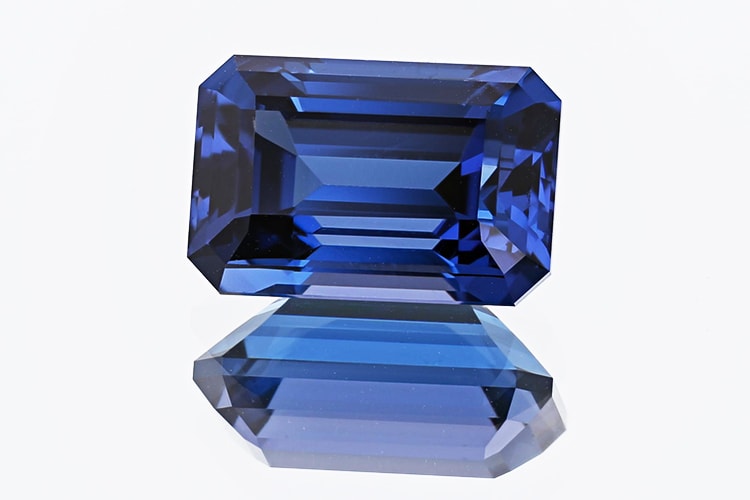Guide to Tanzanite

History, Lore and Appreciation
Tanzanite, a variety of the mineral zoisite, is a relatively new gemstone on the market so it does not share the depth of history presented by other gems. Its beauty, though, is no less appealing, and the history it does have is intriguing. In years to come, tanzanite’s find will clearly be looked back upon as one of the most significant new gem discoveries of the 20th Century.
Several stories relate the discovery of tanzanite. The one most often told is that of Manuel De Souza, a tailor from Goa, India, living in Arusha, Tanzania. On July 7, 1967, De Souza (who doubled as a gold and gemstone prospector) found himself in the hilly region of Merelani in the company of four Masai tribesmen he had hired to help him prospect.
The region, at the foothills of majestic Mount Kilimanjaro, was dangerous: poisonous snakes, Cape buffalo, lions and other African animals roamed the area. Accounts say De Sousa was unarmed but for a few prospecting tools, seeking only what providence might offer. But rather than being discovered by man-eating beasts, De Sousa made a startling discovery himself. Around noon, he discovered a blue crystal lying on the ground. The crystal was unknown to him, though after consulting a few books, De Sousa soon discounted sapphire and the mineral cordierite (iolite) as possibilities. He finally decided it was a form of olivine, or at least was the closest gemological match, and on July 25 pegged a claim for it. Soon other claims were made near his – but the material was now being called something else: zoisite. Though it may have originally been confused with it, zoisite is a different mineral than olivine. According to John Saul, a geologist and gem miner from Tanzania, confirmations of the mineral zoisite soon came from the Gemological Institute of America and from other experts around the world.
Henry Platt, vice president of Tiffany & Co., who had been shown the material and admired it, was the first to call it “tanzanite,” in honor of the country where it was found; the name was soon duly inscribed in new gemological texts. Indeed, tanzanite is not mined elsewhere on a commercial basis. While almost all of the material coming out of the mines at Merelani was (and is) a somewhat drab purplish to yellowish brown, it was soon found that low grade heating turned the gems into a deep purplish blue. While some blue zoisite is that color naturally, it is understood that virtually all of the commercially mined zoisite today is heated to induce the deep, velvety, blue to violet blue colors associated with the gem.
There is much to appreciate about tanzanite: its deep blue to violet colors is, of course, paramount. It can be found in sizable crystals suitable for centre stones in jewelry. It is also trichroic, meaning that it shows three different colors in the three crystallographic directions. As a result, tilting the gem in three different directions one is sometimes able to discern deep purple/red, blue, and yellow/brown. Viewed in
a polariscope, these colors become even more evident.
Birthstones and Anniversaries
Tanzanite has been added as a birthstone for the month of December, along with zircon and turquoise.
Description and Properties
A variety of the mineral species zoisite (in the epidote group) forming in the orthorhombic crystal system with
the following approximate chemical composition: Ca2Al3(SiO4)3(OH).
Color(s): Transparent blue to violet to bluish purple zoisites are called tanzanite. However, other colors are also mined in Merelani, including pink, purple, yellow, and green. These are sometimes referred to as “fancy tanzanites” in the trade. While they are all zoisite, only the deep purplish- blue colors can be called tanzanite.
Refractive Index: 1.691 to 1.700 (±0.005) Birefringence: 0.008 to 0.013
Specific Gravity: 3.35 (+0.10, -0.25) Cause(s) of color: Blue: vanadium. Mohs Hardness: 6 to 7
Internal identifying characteristics: Tanzanite tends to be remarkably clean and transparent. Fingerprint inclusions are sometimes present. On very rare occasions, tiny, parallel, hollow tubes in some tanzanite causes chatoyancy (cat’s eye effect).
Treatments
Heating at relatively low temperatures (up to 600C) causes a change of color from brown, purple or grey to bluish purple to purplish blue. Sometimes tanzanite is coated to improve its color, although this is uncommon.
Collector Quality
Tanzanite in large sizes with rich color is desirable for collections. Multi-color transparent zoisite is also sought, particularly green and pink. On extremely rare occasion, collectible cat’s eye tanzanite is fashioned.
Localities
Merelani, Tanzania. At the time of writing, Merelani is the only known commercial locality for tanzanite in the world. While zoisite does occur in other places, no material matches the color intensity of tanzanite.
Cutting, Care and Cleaning
Tanzanite is delicate and should be worn with great care. Tanzanite should never be cleaned in an ultrasonic cleaner or steam cleaned. Warm soapy water or a damp soft cloth is considered a safe way to clean tanzanite jewelry.
Source: CIBJO Retailers’ Reference Guide